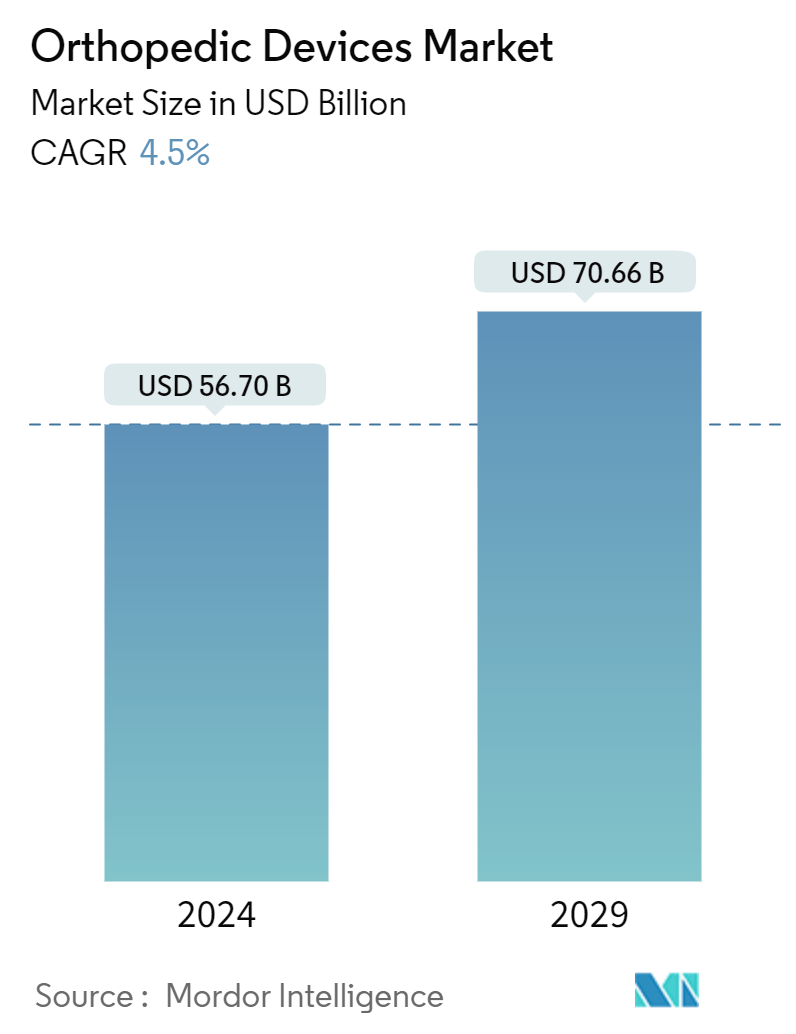Market Size of Orthopedic Devices Industry

| Study Period | 2019 - 2029 |
| Market Size (2024) | USD 56.70 Billion |
| Market Size (2029) | USD 70.66 Billion |
| CAGR (2024 - 2029) | 4.50 % |
| Fastest Growing Market | Asia Pacific |
| Largest Market | North America |
Major Players
*Disclaimer: Major Players sorted in no particular order |
Orthopedic Devices Market Analysis
The Orthopedic Devices Market size is estimated at USD 56.70 billion in 2024, and is expected to reach USD 70.66 billion by 2029, growing at a CAGR of 4.5% during the forecast period (2024-2029).
The COVID-19 pandemic had a significant impact on the orthopedic devices market. An article published in BMJ Case Reports in February 2021 reported that the first wave of the COVID-19 pandemic in the United States led to the postponement or cancelation of elective and non-urgent surgeries to conserve healthcare resources. The article also reported that orthopedic surgeries in the region decreased by 68.4% during the first wave of the pandemic, which impacted the growth of the studied market. Thus, the studied market initially witnessed significant challenges due to the cancellation of orthopedic surgeries caused by government regularization. However, with the decrease in COVID-19 cases and the resumption of orthopedic surgical procedures, the studied market is expected to witness significant growth over the forecast period.
The factors driving the growth of the studied market are the increasing number of joint reconstruction surgeries, the growing burden of orthopedic disorders, trauma, and accident cases, and the development of bioabsorbable and titanium implants. For instance, the OECD database reported that 2,794.5 per million people got injured in road accidents in Iceland, followed by 1,230 per million people in Ireland and 2,867.9 per million in Japan in 2021. A high number of road injuries may lead to an increase in bone damage cases, which will increase the demand for orthopedic devices, thereby driving the growth of the studied market.
Also, a high incidence of joint surgeries is reported among the geriatric population. The geriatric population has weaker bones, so they are more prone to accidents and other bone deformities. The United Nations Projections 2022 report stated that in 2022, there were 771 million people aged 65 years or over globally, and the number is projected to reach 994 million by 2030 and 1.6 billion by 2050. Similarly, an article published in the journal JARS, published in July 2021 reported that aging weakens the bone-tendon junction and decreases the ultimate tensile strength, leading to an increased risk of joint damage. Thus, the increasing cases of joint damage conditions coupled with increasing aging are leading to an increasing number of orthopedic surgeries, thereby driving the growth of the studied market.
Also, the rise in musculoskeletal diagnoses and osteoporosis-related fractures is boosting the demand for orthopedic implants among the elderly. For instance, in December 2021, Work-Related Musculoskeletal Disorders Statistics in Great Britain Report stated that the total number of cases of work-related musculoskeletal disorders in 2020/21 was 470,000, with a prevalence rate of 1,420 per 100,000 workers. These comprised 212,000 cases where the upper limbs or neck were affected, 182,000 where the back was affected, and 76,000 where the lower limbs were affected. The report also stated that this number increased significantly compared to the previous years. Thus, the rise in cases of musculoskeletal disorders is leading to growing orthopedic surgeries, driving the growth of the studied market.
Furthermore, technological developments and new product launches are also benefitting the market. For instance, in February 2022, 4WEB Medical launched a comprehensive array of hyperlordotic lateral implants. The implants combined with 4WEB's Lumbar Spine Plating Solution allow for more cost-effective treatment options and reduce the need for more extensive, invasive posterior corrective procedures. Thus, such new product launches are leading the development of better orthopedic devices, thereby driving the growth of the studied market.
Thus, due to the increasing number of significant joint reconstruction surgeries, the growing burden of orthopedic disorders, trauma, and accident cases, and the development of bioabsorbable and titanium implants, the studied market is expected to witness significant growth over the forecast period. However, stringent regulatory scenarios and poor reimbursement scenarios, and a lack of skilled surgeons may hamper the development of the market.
Orthopedic Devices Industry Segmentation
Orthopedic devices are used to replace missing joints or bones or to give support to damaged bones. The devices are fabricated using titanium alloys and stainless steel for strength, and the plastic coating acts as artificial cartilage. Internal fixation is a surgery in orthopedics that involves the implementation of implants to repair damaged bone.
The Orthopedic Devices Market is Segmented by Application (Hip Orthopedic Devices, Knee Orthopedic Devices, Spine Orthopedic Devices, Trauma Fixation Devices, Dental Orthopedic Devices, and Other Applications) and Geography (North America, Europe, Asia-Pacific, Middle East and Africa, and South America). The market report also covers the estimated market sizes and trends for 17 different countries across major regions globally. The report offers the value (in USD million) for the above segments.
| By Application | |
| Hip Orthopedic Devices | |
| Knee Orthopedic Devices | |
| Spine Orthopedic Devices | |
| Trauma Fixation Devices | |
| Dental Orthopedic Devices | |
| Other Applications |
| By Geography | ||||||||
| ||||||||
| ||||||||
| ||||||||
| ||||||||
|
Orthopedic Devices Market Size Summary
The orthopedic devices market is poised for substantial growth over the forecast period, driven by an increasing number of joint reconstruction surgeries and a rising prevalence of orthopedic disorders. The market's expansion is further supported by advancements in bioabsorbable and titanium implants, which are becoming increasingly popular due to their benefits in surgical procedures. The geriatric population, with its higher susceptibility to bone deformities and injuries, is a significant contributor to the demand for orthopedic devices. Additionally, the rise in musculoskeletal disorders and osteoporosis-related fractures, particularly among the elderly, is fueling the need for orthopedic implants. Technological innovations and new product launches, such as those by 4WEB Medical, are enhancing the capabilities of orthopedic devices, thereby supporting market growth.
Regionally, North America is expected to experience significant growth due to its robust healthcare infrastructure, strong distribution networks, and the presence of key industry players. The high incidence of orthopedic surgeries in this region, coupled with the increasing prevalence of orthopedic disorders, is driving demand for orthopedic devices. In Mexico, the rising prevalence of conditions like rheumatoid arthritis is also contributing to market expansion. The market is characterized by intense competition, with major players like Smith & Nephew PLC, Stryker Corporation, and Medtronic PLC focusing on continuous product development and strategic acquisitions to enhance their market positions. Innovations such as Ortho Development's BKS Uni Partial Knee System are expected to further boost market growth by improving surgical efficiency.
Orthopedic Devices Market Size - Table of Contents
-
1. MARKET DYNAMICS
-
1.1 Market Overview
-
1.2 Market Drivers
-
1.2.1 Increasing Number of Large Joint Reconstruction Surgeries
-
1.2.2 Growing Burden of Orthopedic Disorders, Trauma, and Accidents Cases
-
1.2.3 Development of Bioabsorbable and Titanium Implants
-
-
1.3 Market Restraints
-
1.3.1 Stringent Regulatory Scenario
-
1.3.2 Poor Reimbursement Scenario and Lack of Skilled Surgeons
-
-
1.4 Industry Attractiveness - Porter's Five Forces Analysis
-
1.4.1 Threat of New Entrants
-
1.4.2 Bargaining Power of Buyers
-
1.4.3 Bargaining Power of Suppliers
-
1.4.4 Threat of Substitute Products
-
1.4.5 Intensity of Competitive Rivalry
-
-
-
2. MARKET SEGMENTATION (Market Size by Value - USD Million)
-
2.1 By Application
-
2.1.1 Hip Orthopedic Devices
-
2.1.2 Knee Orthopedic Devices
-
2.1.3 Spine Orthopedic Devices
-
2.1.4 Trauma Fixation Devices
-
2.1.5 Dental Orthopedic Devices
-
2.1.6 Other Applications
-
-
2.2 By Geography
-
2.2.1 North America
-
2.2.1.1 United States
-
2.2.1.2 Canada
-
2.2.1.3 Mexico
-
-
2.2.2 Europe
-
2.2.2.1 Germany
-
2.2.2.2 United Kingdom
-
2.2.2.3 France
-
2.2.2.4 Italy
-
2.2.2.5 Spain
-
2.2.2.6 Rest of Europe
-
-
2.2.3 Asia-Pacific
-
2.2.3.1 China
-
2.2.3.2 Japan
-
2.2.3.3 India
-
2.2.3.4 Australia
-
2.2.3.5 South Korea
-
2.2.3.6 Rest of Asia-Pacific
-
-
2.2.4 Middle East and Africa
-
2.2.4.1 GCC
-
2.2.4.2 South Africa
-
2.2.4.3 Rest of Middle East and Africa
-
-
2.2.5 South America
-
2.2.5.1 Brazil
-
2.2.5.2 Argentina
-
2.2.5.3 Rest of South America
-
-
-
Orthopedic Devices Market Size FAQs
How big is the Orthopedic Devices Market?
The Orthopedic Devices Market size is expected to reach USD 56.70 billion in 2024 and grow at a CAGR of 4.5% to reach USD 70.66 billion by 2029.
What is the current Orthopedic Devices Market size?
In 2024, the Orthopedic Devices Market size is expected to reach USD 56.70 billion.

